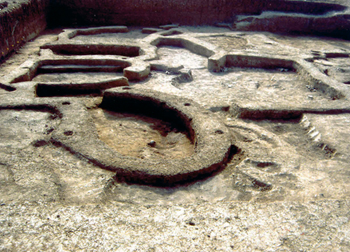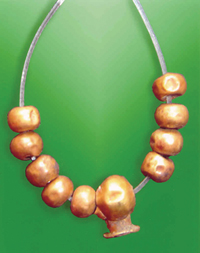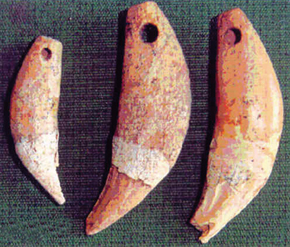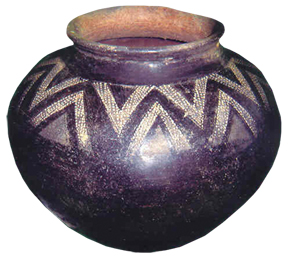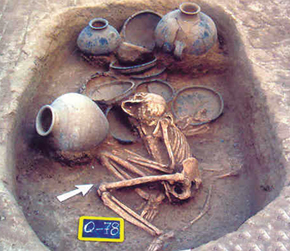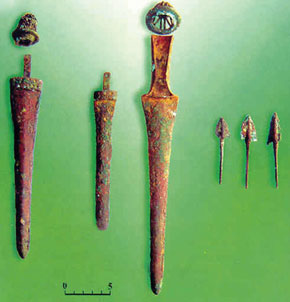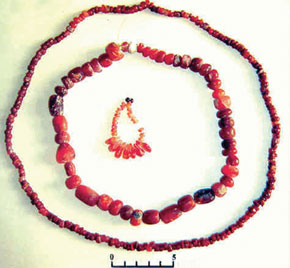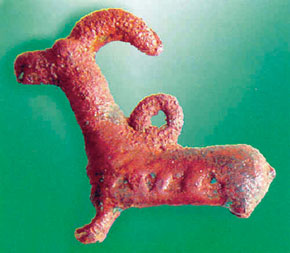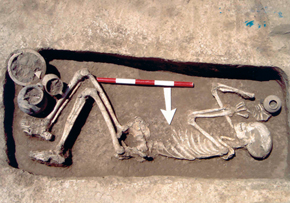Excavations on pipeline route yield valuable finds
Pages 48-53
by PhD Nacaf Musabeyli
Archaeological excavations, before new buildings are constructed have a special place in the history of archaeology. The first excavations of this kind were carried out in Azerbaijan in 1946-53 because of the building of the Mingachevir hydro-electric power station.
These excavations were of special importance to the archaeology of the whole Caucasus, not just Azerbaijan. The excavations along the planned route of the Baku-Tbilisi-Ceyhan oil pipeline and the Baku-Tbilisi-Erzurum South Caucasus gas pipeline can be compared with the Mingachevir excavations in terms of the variety of archaeological material. Excavations were carried out in 2001-05 in 41 sectors along the pipelines´ corridor, which is 44 m wide. The work unearthed the remains of hundreds of tombs and ancient settlements from the end of the Copper Age (Chalcolithic or Eneolithic Age, the first half of the 4th millennium BC) right up to the Middle Ages inclusive. These sites were found mainly in Western Azerbaijan, along the middle reaches of the Kur River. From ancient times the favourable geography of the region attracted tribes engaged in agriculture and cattle-breeding.
The oldest sites found on the route of the pipelines date to the end of the Copper Age. These are the settlements of Khojakhan and Agili dere in Tovuz Distirct and Poylu I, Poylu II, Boyuk-Kesik I and Soyugbulag barrows in Akstafa District. In these settlements many artefacts were found which show the material, spiritual and cultural life of the settlers in this region. The remains of farmsteads and private dwellings (photo 1), tools of stone and bone, metal articles and a huge number of clay vessels, human and animal figures prepared from clay and bone etc. were found. Excavations in agricultural pits found the remains of grain, scythes and other stone tools, which were used for agriculture and are reliable sources of information on the economic life of the population of Azerbaijan in the late Copper Age. Many bones of cattle and other domestic animals were found in the settlements. These finds are evidence of the high development of crafts such as pottery, bone working, stone working, metal working and weaving of the settled agricultural and cattle-breeding tribes.
Apart from Khojakhan, all the aforementioned Copper Age sites concern the Leylatepe archaeological culture or people. The Leylatepe people emerged in the first half of the 4th millennium BC as the result of the migration of the Ubaid tribes from Mesopotamia to the South Caucasus, especially Azerbaijan. The Leylatepe people were named after the site of the same name in Agdam District which was excavated in the 1980s. The Soyugbulag barrows, the first barrows of the Copper Age in the whole South Caucasus, are especially important remains of the Leylatepe culture. After inhabiting the Northern Caucasus in the second half of the 4th millennium BC, the Leylatepe people became part of the Maykop people. Therefore, the research into the remains of the Leylatepe culture is of great importance in the study of the cultural, economic and ethnic links of the Caucasus and the Middle East.
Some of the barrows discovered and excavated along the pipeline route belong to the Kur-Araz culture of the early Bronze Age. These barrows date to the final period of this culture, i.e. the third quarter of the 3rd millennium BC. On the left bank of the Shamkirchay River three such barrows were studied. They are made of earth and cobbles alternately and have a diameter of up to 20 m. In these barrows the dead were buried in a contorted position on either their left or right side. Excavation of these burial mounds found clay vessels, jewellery, household items and various weapons. Gold beads (photo 2) and a bronze mirror are the most notable of the finds. Other beads were made from cornelian, paste, mother-of-pearl and the bones of various animals (photo 3). The excavation of the Shamkirchay barrows provides significant evidence about the funeral ceremonies of the early Bronze Age in Azerbaijan.
The excavated barrow on the left bank of the Hasansu in Akstafa District is the only site of the Middle Bronze Age in the BTC and BTE pipeline corridor. A young man had a luxurious burial in this barrow, which is of structural interest. A burial set of clay vessels and sacrificed animals were placed on the floor of the burial chamber, and bulls´ heads were cut off and deliberately placed in the corners. All the burial items were covered with what may have been a wooden covering. Over the covering a special place (most likely a lodge) designed for the burial itself was prepared from limestone slabs and trees. Once the corpse had been placed in position, the entire burial chamber was first filled with earth, then cobbles and earth alternately. It is striking that more attention was paid to the burial equipment and funeral ceremony than the dead. The special position of the bulls´ skulls and the arrangement of the vessels suggest that the funeral was held on a cart yoked to the bulls. Seventy-two clay vessels and pieces of jewellery were found in this barrow. Most of the black glazed crockery was decorated with white inlay work (photo 4).
In the late Bronze and early Iron Ages (the second half of the 2nd millennium BC to the early 1st millennium BC) all branches of agriculture developed intensively in the whole South Caucasus, including Azerbaijan. Farming and especially cattle-breeding reached a higher level of development, different crafts prospered and cultural and economic relations reached a hitherto unheard of scale. A remarkable volume and variety of archaeological materials were discovered in the burial chambers of this period (photo 5). Large amounts of clay vessels were found in the graves, as were stone and bronze weapons (photo 6), cornelian beads (photo 7), paste and animal-shaped pendants, parts of belts, bracelets, rings, ear-rings and other jewellery items. Some graves in the Zeimchay necropolis in Shemkirchay District were covered in red ochre.
People were found buried with dogs in the Tovuzchay necropolis. During the late Bronze-early Iron Age dogs played an important role in agricultural life, especially cattle-breeding, and this led to the development of a dog cult. The ancient people probably buried dogs in the Tovuzchay necropolis so that they could defend the dead in the other world.
Borsunlu barrow in Goranboy District, dating back to the 13th century BC, is of interest for the burial of a warrior in a sitting position. The skeleton of a horse, a bronze dagger and bronze and stone arrow-heads were found in the grave.
Finds from the period of classical antiquity along the pipeline corridor (4th- 3rd centuries BC) include pitchers, earth burial chambers and one timber framework grave. They were excavated in Agdash, Yevlakh, Goranboy and Akstafa districts. As in previous periods the dead were buried in a contorted position either on their right or left sides. The funeral equipment was placed inside the funeral pitcher and large vessels were placed around it.
In the earth graves dating from the early Middle Ages (4th-8th centuries AD) the dead were buried in a less contorted position (photo 9), unlike in previous periods. Objects from daily household life were found in the graves more often than in other periods. Most of the earth graves of the early Middle Ages excavated in Akstafa District were women´s graves and included items connected with weaving. Christianity is known to have been the main religion of the Albanian tribes of western and north-western Azerbaijan. The graves of early Christians were excavated in several sectors along the pipeline corridor.
The most interesting of them is an early Christian site excavated near Chaparli village in Shamkir District. The excavations found the remains of a Christian church and Christian graves in and around the church.
Many years of archaeological excavations in Azerbaijan´s large cities of the medieval period (9th-18th centuries AD), Baku, Ganja, Shamakhi, Beylagan, Barda, Shemkir, Nakhchivan and others, have yielded extensive scientific information. But village settlements of this period have not received much attention in Azerbaijan. From this point of view the excavations in the pipeline area provided an opportunity to study many sites, including Fakhrali, Laki, Hajili, Dashbulag, Qiraq Kesemen and others. The excavations found the remains of material culture which allow the study of agricultural life in villages in medieval Azerbaijan.
Implementation of the Contract of the Century, therefore, not only increased Azerbaijan´s economic and political potential, but also stimulated the study of Azerbaijan´s ancient history through the comprehensive study of archaeological sites in the pipeline area, thereby overcoming the stagnation of the 1990s in Azerbaijani archaeology.
Director of archaeological excavations on the BTC and South Caucasus pipeline projects, PhD in history, Nacaf Musabeyli
Pages 48-53
by PhD Nacaf Musabeyli
Archaeological excavations, before new buildings are constructed have a special place in the history of archaeology. The first excavations of this kind were carried out in Azerbaijan in 1946-53 because of the building of the Mingachevir hydro-electric power station.
These excavations were of special importance to the archaeology of the whole Caucasus, not just Azerbaijan. The excavations along the planned route of the Baku-Tbilisi-Ceyhan oil pipeline and the Baku-Tbilisi-Erzurum South Caucasus gas pipeline can be compared with the Mingachevir excavations in terms of the variety of archaeological material. Excavations were carried out in 2001-05 in 41 sectors along the pipelines´ corridor, which is 44 m wide. The work unearthed the remains of hundreds of tombs and ancient settlements from the end of the Copper Age (Chalcolithic or Eneolithic Age, the first half of the 4th millennium BC) right up to the Middle Ages inclusive. These sites were found mainly in Western Azerbaijan, along the middle reaches of the Kur River. From ancient times the favourable geography of the region attracted tribes engaged in agriculture and cattle-breeding.
The oldest sites found on the route of the pipelines date to the end of the Copper Age. These are the settlements of Khojakhan and Agili dere in Tovuz Distirct and Poylu I, Poylu II, Boyuk-Kesik I and Soyugbulag barrows in Akstafa District. In these settlements many artefacts were found which show the material, spiritual and cultural life of the settlers in this region. The remains of farmsteads and private dwellings (photo 1), tools of stone and bone, metal articles and a huge number of clay vessels, human and animal figures prepared from clay and bone etc. were found. Excavations in agricultural pits found the remains of grain, scythes and other stone tools, which were used for agriculture and are reliable sources of information on the economic life of the population of Azerbaijan in the late Copper Age. Many bones of cattle and other domestic animals were found in the settlements. These finds are evidence of the high development of crafts such as pottery, bone working, stone working, metal working and weaving of the settled agricultural and cattle-breeding tribes.
Apart from Khojakhan, all the aforementioned Copper Age sites concern the Leylatepe archaeological culture or people. The Leylatepe people emerged in the first half of the 4th millennium BC as the result of the migration of the Ubaid tribes from Mesopotamia to the South Caucasus, especially Azerbaijan. The Leylatepe people were named after the site of the same name in Agdam District which was excavated in the 1980s. The Soyugbulag barrows, the first barrows of the Copper Age in the whole South Caucasus, are especially important remains of the Leylatepe culture. After inhabiting the Northern Caucasus in the second half of the 4th millennium BC, the Leylatepe people became part of the Maykop people. Therefore, the research into the remains of the Leylatepe culture is of great importance in the study of the cultural, economic and ethnic links of the Caucasus and the Middle East.
Some of the barrows discovered and excavated along the pipeline route belong to the Kur-Araz culture of the early Bronze Age. These barrows date to the final period of this culture, i.e. the third quarter of the 3rd millennium BC. On the left bank of the Shamkirchay River three such barrows were studied. They are made of earth and cobbles alternately and have a diameter of up to 20 m. In these barrows the dead were buried in a contorted position on either their left or right side. Excavation of these burial mounds found clay vessels, jewellery, household items and various weapons. Gold beads (photo 2) and a bronze mirror are the most notable of the finds. Other beads were made from cornelian, paste, mother-of-pearl and the bones of various animals (photo 3). The excavation of the Shamkirchay barrows provides significant evidence about the funeral ceremonies of the early Bronze Age in Azerbaijan.
The excavated barrow on the left bank of the Hasansu in Akstafa District is the only site of the Middle Bronze Age in the BTC and BTE pipeline corridor. A young man had a luxurious burial in this barrow, which is of structural interest. A burial set of clay vessels and sacrificed animals were placed on the floor of the burial chamber, and bulls´ heads were cut off and deliberately placed in the corners. All the burial items were covered with what may have been a wooden covering. Over the covering a special place (most likely a lodge) designed for the burial itself was prepared from limestone slabs and trees. Once the corpse had been placed in position, the entire burial chamber was first filled with earth, then cobbles and earth alternately. It is striking that more attention was paid to the burial equipment and funeral ceremony than the dead. The special position of the bulls´ skulls and the arrangement of the vessels suggest that the funeral was held on a cart yoked to the bulls. Seventy-two clay vessels and pieces of jewellery were found in this barrow. Most of the black glazed crockery was decorated with white inlay work (photo 4).
In the late Bronze and early Iron Ages (the second half of the 2nd millennium BC to the early 1st millennium BC) all branches of agriculture developed intensively in the whole South Caucasus, including Azerbaijan. Farming and especially cattle-breeding reached a higher level of development, different crafts prospered and cultural and economic relations reached a hitherto unheard of scale. A remarkable volume and variety of archaeological materials were discovered in the burial chambers of this period (photo 5). Large amounts of clay vessels were found in the graves, as were stone and bronze weapons (photo 6), cornelian beads (photo 7), paste and animal-shaped pendants, parts of belts, bracelets, rings, ear-rings and other jewellery items. Some graves in the Zeimchay necropolis in Shemkirchay District were covered in red ochre.
People were found buried with dogs in the Tovuzchay necropolis. During the late Bronze-early Iron Age dogs played an important role in agricultural life, especially cattle-breeding, and this led to the development of a dog cult. The ancient people probably buried dogs in the Tovuzchay necropolis so that they could defend the dead in the other world.
Borsunlu barrow in Goranboy District, dating back to the 13th century BC, is of interest for the burial of a warrior in a sitting position. The skeleton of a horse, a bronze dagger and bronze and stone arrow-heads were found in the grave.
Finds from the period of classical antiquity along the pipeline corridor (4th- 3rd centuries BC) include pitchers, earth burial chambers and one timber framework grave. They were excavated in Agdash, Yevlakh, Goranboy and Akstafa districts. As in previous periods the dead were buried in a contorted position either on their right or left sides. The funeral equipment was placed inside the funeral pitcher and large vessels were placed around it.
In the earth graves dating from the early Middle Ages (4th-8th centuries AD) the dead were buried in a less contorted position (photo 9), unlike in previous periods. Objects from daily household life were found in the graves more often than in other periods. Most of the earth graves of the early Middle Ages excavated in Akstafa District were women´s graves and included items connected with weaving. Christianity is known to have been the main religion of the Albanian tribes of western and north-western Azerbaijan. The graves of early Christians were excavated in several sectors along the pipeline corridor.
The most interesting of them is an early Christian site excavated near Chaparli village in Shamkir District. The excavations found the remains of a Christian church and Christian graves in and around the church.
Many years of archaeological excavations in Azerbaijan´s large cities of the medieval period (9th-18th centuries AD), Baku, Ganja, Shamakhi, Beylagan, Barda, Shemkir, Nakhchivan and others, have yielded extensive scientific information. But village settlements of this period have not received much attention in Azerbaijan. From this point of view the excavations in the pipeline area provided an opportunity to study many sites, including Fakhrali, Laki, Hajili, Dashbulag, Qiraq Kesemen and others. The excavations found the remains of material culture which allow the study of agricultural life in villages in medieval Azerbaijan.
Implementation of the Contract of the Century, therefore, not only increased Azerbaijan´s economic and political potential, but also stimulated the study of Azerbaijan´s ancient history through the comprehensive study of archaeological sites in the pipeline area, thereby overcoming the stagnation of the 1990s in Azerbaijani archaeology.
Director of archaeological excavations on the BTC and South Caucasus pipeline projects, PhD in history, Nacaf Musabeyli
